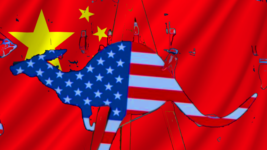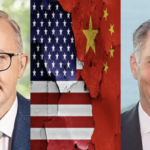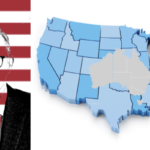The US-led Military Buildup in Australia Is Like Nothing We’ve Seen Before

Morrison standing on a podium announcing AUKUS side-by-side a televised US president Joe Biden and UK PM Boris Johnson in September 2021 was a kick in the guts to the nation, as we learnt that Australia was entering into the AUKUS security pact, acquiring attack submarines and going nuclear.
But when Albanese took his moment on a San Diego podium to lay out the AUKUS deal in March, with at least $368 billion from the taxpayer purse to pay for eight nuclear-powered subs, along with the US and UK establishing a rotational submarine force in the west, it was beyond comprehension.
And ever since then, the drive to war, which involves establishing this continent as a frontline base for the US, just hasn’t let up.
Australia is being designated a US domestic military source. A competition was running for high school kids to design nuclear-powered submarine propulsion systems. We’re establishing a local guided weapons industry, and there’s a star-spangled kangaroo floating around in the Indo Pacific.
The onslaught almost feels like the continent is being colonised again. Indeed, former Australian foreign minister Bob Carr has stated that it’s clear Australia is sinking “into the role of US territory, as much a dependency as Guam or Puerto Rico”.
And this full throttle approach to militarising the nation from the top down, which shifted into overdrive following Albanese’s AUKUS announcement, is something Australia has never seen before.
Setting sail with no guarantees
“Australia’s wars have typically been preceded by minimal buildup, recruitment, and weapons preparation,” said Australians for War Powers Reform (AWPR) president Dr Alison Broinowski. “Our contributions to them have been as small as governments could manage, while obliging our allies.”
“This time it is different because the US, having reverted to making China the enemy, wants its allies in the Pacific to bear the brunt of the war,” the former Australian diplomat told Sydney Criminal Lawyers.
This country is throwing all of its worth behind the US escalation in our region. Yet, Dr Mike Gilligan points out in a recent article that the ANZUS Treaty doesn’t guarantee the US will assist an Australia under attack, which is an assurance that Washington does have with its 30-odd NATO allies.
Broinowski outlines that if Japan and South Korea aren’t prepared to be the US frontline that leaves Australia, “where China has been accepted in defence policy circles as our enemy”. And if a full-scale war in the Indo Pacific wasn’t favouring the US, well, they’d be no reason for it to stick around.
“Hence the massive militarisation of our economy, at the expense of other priorities,” the AWPR president added. “No-one in those circles asks about the effect on our trade and prosperity if we go to war against China to defend our trade routes with our major trade partner.”
The horror, the horror
US ambassador to Australia Caroline Kennedy told the Today program last month that “we have no stronger, more trusted, more capable partner than Australia”. The arrival of JFK’s daughter in this country last July to take on this role clearly reflects the change in climate.
In response to a question regarding it not necessarily being an “easy time right now with everything happening in China”, Kennedy responded, “No you are right, as the foreign minister says, this is a time of very challenging strategic circumstances”, adding that Biden sent her to strengthen the alliance.
One of the key announcements made during July’s AUSMIN meeting held in Sydney was the boost to Australia’s growing war industry that manufacturing missiles for the US to use as a secondary source will be. And it will further ensure that the nation has its own weapons on hand if need be.
This development is in line with the Defence Strategic Review 2023 released in April. It outlined that Australia will be increasingly bolstering its war industry – something of our own military-industrial complex – whilst our “defence” forces become increasingly interoperable with the US military.
Much of this has been going on behind the scenes since Gillard agreed to the US force posture initiatives in 2011, which was part of the Obama administration’s pivot to Asia. And Abbott went on to officially establish these initiatives in 2014, under the Force Posture Agreement.
The FPA provides that there’s a constant presence of 2,500 US marines in the north of the continent, whilst the US and Australian air forces are becoming increasingly interoperable, and Washington has unimpeded access to certain local bases and areas.
If the US decides to upgrade one of these bases, its military takes complete control of the facility. And as human rights lawyer Kellie Tranter recently established via FOI, the Australian public is not allowed to see the document outlining “these agreed facilities and areas”.
However, the public is aware that RAAF Base Tindal in the NT is one of these bases, as it came to light last November that it’s being renovated to incorporate building facilities to store six nuclear-capable US B-52 bombers that are obviously a threat to Beijing.
While Australian defence secretary Greg Moriarity explained during estimates last February that these bombers, or indeed, any US warships or submarines, could be carrying nuclear warheads for all the government knows, as for decades it’s respected Washington’s policy of warhead ambiguity.
Finger on the trigger
Dr Broinowski has long been fighting for war power reforms. War powers is the ability to make the decision on whether Australia enters into a foreign conflict. The president of AWPR wants to see it become a parliamentary decision, but currently, it’s basically in the hands of one person: the PM.
More clearly, it’s the National Security Committee that gives the nod to war, which is a group of key ministers that the prime minister has personally selected to decide to go to war on China at the moment the White House orders him to.
The ministers making up the committee at present are Albanese, Penny Wong, Richard Marles, Jim Chalmers, Chris Bowen, Mark Dreyfus, Clare O’Neil, Katy Gallagher and Pat Conroy. These are the people who decide if the nation’s young will risk their lives in battle.
AWPR was pleased with federal Labor’s guarantee to establish a war powers reform inquiry pre-election and its launch post-election. However, Broinowski and her associates weren’t too happy in April, when the report it produced denied parliament to have a say in whether we enter any war.
But this wasn’t so unexpected as hawkish defence minister Marles wrote to the committee last October to suggest it didn’t recommend reform, while foreign minister Wong told parliament, it was important for national security that the decision remains a prerogative of the executive in February.
“Marles and Wong insist on preserving the power of the executive government over committing armed forces to overseas war,” Dr Broinowski made clear.
“Labor has rejected WPR without proposing an alternative, such as armed neutrality, non-alignment, or nuclear disarmament, which some groups are calling for.”
In August, however, the Albanese government responded to the inquiry’s findings with a midway alternative, as it’s going to permit parliament to debate the decision to go to war after the PM has made it. And this debate can occur prior to deployment or within 30 days of it.
Federal Labor has also determined, in line with an inquiry recommendation, that the Joint Standing Committee on Defence be established to oversight the Australian Defence Forces, the Department of Defence and all their documents and policies.
“Offering a new joint committee on Defence actually weakens the former Standing Committee on Foreign Affairs Defence and Trade, giving defence even more power,” explained Dr Broinowski, who, in her time as a diplomat, was in the employment of DFAT.
“It’s clear that they are building a cable-car to take us over the top to war,” the AWPR president said in conclusion. “All that’s missing is the US finding an excuse to start it up and telling Australia when to get on board.”







